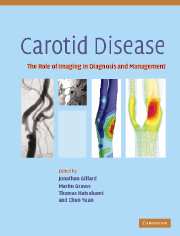Book contents
- Frontmatter
- Contents
- List of contributors
- List of abbreviations
- Introduction
- Background
- Luminal imaging techniques
- Morphological plaque imaging
- Functional plaque imaging
- 19 Nuclear imaging for the assessment of patients with carotid artery atherosclerosis
- 20 USPIO – enhanced magnetic resonance imaging of carotid atheroma
- 21 Gadolinium-enhanced plaque imaging
- 22 Carotid magnetic resonance direct thrombus imaging
- Plaque modelling
- Monitoring the local and distal effects of carotid interventions
- Monitoring pharmaceutical interventions
- Future directions in carotid plaque imaging
- Index
- References
20 - USPIO – enhanced magnetic resonance imaging of carotid atheroma
from Functional plaque imaging
Published online by Cambridge University Press: 03 December 2009
- Frontmatter
- Contents
- List of contributors
- List of abbreviations
- Introduction
- Background
- Luminal imaging techniques
- Morphological plaque imaging
- Functional plaque imaging
- 19 Nuclear imaging for the assessment of patients with carotid artery atherosclerosis
- 20 USPIO – enhanced magnetic resonance imaging of carotid atheroma
- 21 Gadolinium-enhanced plaque imaging
- 22 Carotid magnetic resonance direct thrombus imaging
- Plaque modelling
- Monitoring the local and distal effects of carotid interventions
- Monitoring pharmaceutical interventions
- Future directions in carotid plaque imaging
- Index
- References
Summary
Background
It is well described that vulnerable atheroma has a thin fibrous cap overlying a large, necrotic lipid core often with associated inflammation (Stary, 1994; Stary et al., 1994; Stary et al., 1995; Stary, 2000a, b; Stary, 2001). Over half of the ischemic strokes in the developed world are thought to be due to rupture of extracranial plaque and a significant proportion of this plaque can be found either at the carotid bifurcation or just above the bifurcation in the internal carotid artery (Pasterkamp et al., 1998; Kiechl and Willeit, 1999; Ono et al., 2001; Zhang et al., 2001; Gaigalaite, 2002; Hollander et al., 2002). Plaque rupture involves the mechanical failure of the fibrous cap, thereby exposing the blood to the necrotic lipid core. This endothelial disruption leads to platelet aggregation and the formation of a luminal thrombus which can then either totally occlude the lumen or, more commonly, throw off emboli to the distal intracranial vasculature. Plaques also develop in this manner with organization of the thrombus eventually leading to the seeding of a new fibrous cap from systemic endothelial progenitor cells (Pulvirenti et al., 2000; Littlewood and Bennett, 2003; Stoneman and Bennett, 2004) and an increase in the overall level of stenosis. Histologically this can be demonstrated with many plaque specimens showing evidence of multiple fibrous caps within the substance of the plaque (Figure 20.1).
Keywords
- Type
- Chapter
- Information
- Carotid DiseaseThe Role of Imaging in Diagnosis and Management, pp. 272 - 287Publisher: Cambridge University PressPrint publication year: 2006



